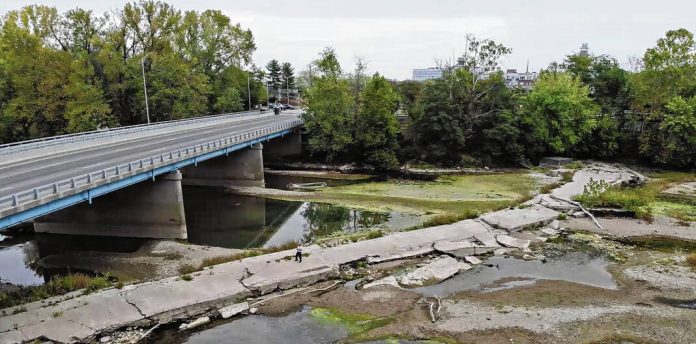
Photo provided An overhead view of the low-head dam in the East Fork White River which would be removed as part of the proposed Riverfront Project.
Columbus City Council has authorized the Columbus Redevelopment Commission to spend almost $11.6 million on the city’s riverfront project, though some residents and at least one council member are skeptical of certain aspects of the proposal.
The vote was 6-1, with Councilman Frank Miller voting against the expense.
“Throughout the years, I think I’ve voiced my opinion on the safety aspects, but you lose me on the in-water features,” he said.
The riverfront project seeks to address safety issues related to the deteriorating low-head dam in the East Fork White River without damaging wetlands upstream or impacting the river water level through Mill Race Park.
In addition, the project is expected to safeguard the riverbanks from ongoing erosion, including on the west side of the river near the Third Street bridge, which was the site of a landfill from 1938 to 1966 that is believed to have accepted 3.46 million gallons of industrial wastes, including solvents, bases, paints and heavy metals, according to the U.S. Environmental Protection Agency.
City officials also have proposed building connections with the People Trail system and an in-water recreation area, branding the project as an effort to “create an iconic riverfront experience that improves safety.”
Redevelopment Director Heather Pope wrote in a memo to City Council that the final design for the project also includes removing invasive vegetation along the riverbanks and replacing it with native species, re-establishing the flow of fish and sedimentation of the river, providing universal access to the river, creating a rock riffle for additional fish habitat and adding lighting along the riverfront trail.
According to the city of Columbus, the total project cost is estimated at a little over $14 million, which includes about $3 million for “general requirements” and contingencies.
“Part of that ($3 million) is earmarked for mobilization, for the equipment, for any job site trip,” said Jason Larrison, assistant vice president of J.S. Held. “Part of that is contingencies.”
The approved resolution authorizes up to $11,583,083 in tax increment funds for the project, and the city has collected an additional $2.432 million from other funding sources, officials said. These include a Regional Economic Acceleration and Development Initiative grant, a Next Level Trails Grant from the Indiana Department of Natural Resources, and contributions from Duke Energy and the Columbus Park Foundation.
Larrison said that the project is expected to be bid in early 2024, with construction starting by the end of March.
Miller asked if the $14 million estimate includes funds already spent on the project, and Pope replied that it does not. Redevelopment Project Coordinator Mikala Brown estimated that those expenses are around $1.5 million, which Miller said would put the actual cost at $15.5 million.
While Miller was the only one to vote against authorizing the $11.58 million for the project, other council members had questions about the project as well, such as the effects on sediment transfer, precautions about possible flooding during construction, the use of limestone for some in-river features, impact on water levels and potential liability concerns.
Until recently, city officials had been navigating a maze of regulatory hurdles in which four environmental regulators — the Indiana Department of Natural Resources, Indiana Department of Environmental Management, U.S. Army Corps of Engineers and U.S. Environmental Protection Agency — needed to sign off the project before bids could go out and construction could start.
One of the final hurdles included getting approval from the U.S. Army Corps of Engineers, which had requested input from the EPA, city officials said previously. The Louisville Division of the U.S. Army Corps of Engineers previously told The Republic that it had approved a permit that would allow the city to proceed with the project on Sept. 21.
Councilwoman Elaine Hilber asked if making changes to the design would mean that the regulatory process starts over, and team members confirmed that it would.
“This is a bill that’s been due for over 20 years, at this point, that we have admittedly ignored as a city,” said Kyle Hendricks, a member of the Columbus Redevelopment Commission who was also part of the citizens’ committee on the project. “And for all of the reasons that you’ve heard about the different ecological risks, rewards of this project, I think from a broad perspective, I think the fact that the city is considering a project like this that really supports and enhances one of our most critical natural resources is a huge step forward.”
Hendricks was one of about 10 individuals who spoke during the time for public comment. Speakers had a mix of opinions; some were in favor of the ecological pieces but not the in-river recreation features, while others said that they were excited about the opportunities for more kayaking.
Columbus resident Grace Patchett said that she isn’t sure the project “fully meets its goals” in terms of protecting the environment and improving quality of life. According to her LinkedIn, Patchett is a laboratory manager at Aquatic Control, Inc in Seymour. The business describes itself as a lake, pond and water resource management company.
“Please remove the low-head dam and create safe river access, but return the river to its natural state and encourage the riverfront to be a space for nature,” she said.




